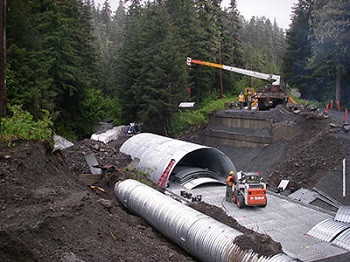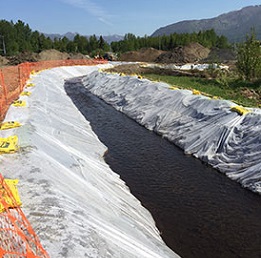Culverts and Bridges
Best Practices

- Culvert design and installation should consider important hydrologic functions such as sediment transport through the culvert, winter icing, flood flow conveyance, and the potential for scouring and scour pool formation at the culvert.
- Culverts should be aligned in a direction as nearly parallel to water flow as possible.
- Installation of culverts & bridges should avoid sensitive fish life stages such as spawning and/or migration periods.
-
 Installation of silt curtains or cofferdams and temporary diversion channels or bypass pumping can be used to isolate the work area from the flowing water of a stream or river.
Installation of silt curtains or cofferdams and temporary diversion channels or bypass pumping can be used to isolate the work area from the flowing water of a stream or river.
- Temporary stream diversions should provide a sufficient quantity of water and a slope and velocity approximating that of the original stream to provide for both upstream and downstream travel of fish.
- Properly installed erosion and sediment control measures are important for preventing impacts to fish habitat from sedimentation. Disturbed areas in a construction site should be stabilized and silt curtains or other measures installed to direct storm water away from fish bearing waterbodies.
- If fish are present in the work area, a Aquatic Resource Permit from ADF&G is required prior to moving fish out of the work area during construction. Contact your local Habitat Section office for more information on relocating fish prior to in-water work (including stream diversion/dewatering).
